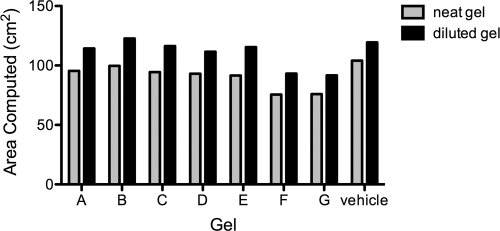Fig 4.
Zinc-carrageenan gels as well as gels containing carrageenan alone are good spreading gels. Shown is the spreadability of different formulations containing 0.5% zinc acetate dihydrate in a carrageenan-based gel using the computed vaginal surface area with undiluted or diluted gel (20% vaginal simulant). Gel rheological measurements of viscosity versus shear rate were performed at 37°C in a TA model AR 1500ex rheometer (TA Instruments, New Castle, DE) using a 4° cone and 20-cm-diameter plate. The 20% dilution is a conservative upper bound limit of the extent of gel dilution over the first 5 min of vaginal spreading in vivo. According to the biomechanical model, optimal spreading is 100 cm2 using 3.5 ml of gel with a force of 1 pound-force (lbf) for 300 s. The experiment includes a control with 3% carrageenan (vehicle). The measurement of rheological properties and subsequent computations of coated area were performed in triplicate for each gel, undiluted and diluted (three independent rheometric experiments with subsequent computations of coated area performed for each gel). Coefficients of variation for the rheometric parameters, computed from the raw rheometric data and subsequent computations of coated area, were all less than 5%. The data represent median values.

